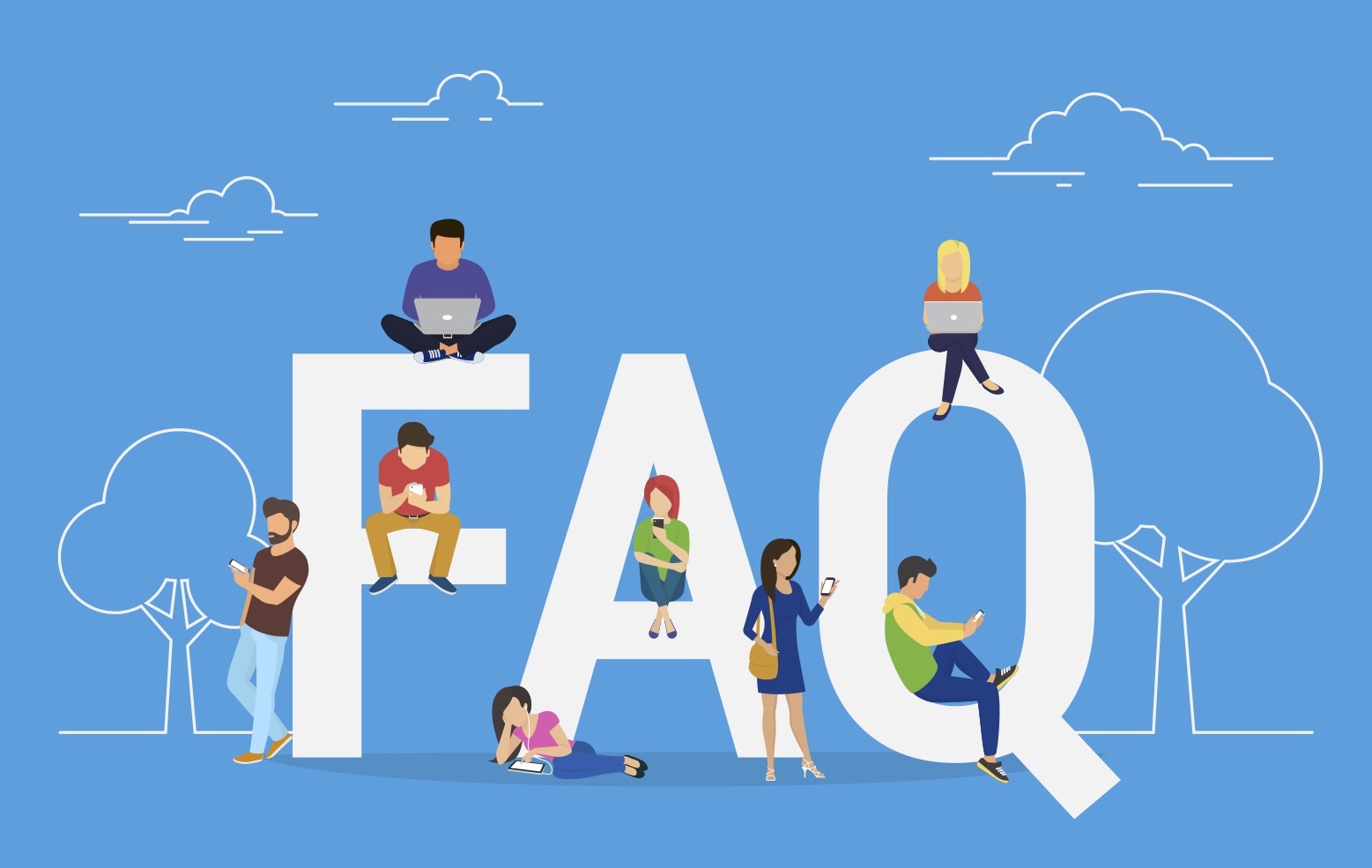
Chatbots aren’t a one-size fits all solution. You might be selling yourself short if you take it out of pocket that the genesis of design and tech is your one experience on Facebook Messenger or with a simple-use application, like a weather bot.
Conversational AI is both just getting started and is also ready for the big time, despite what naysayers relay. Even though you might have a basic understanding of how chatbots work, and now know a little more about NLP, for instance, there’s a slew of questions most people have because that’s just how tech works. Many times, marketing, IT and innovation professionals are continuing to get a handle on how nimble the technology is and that can lead to even more questions, which we have the answers too, here.
Right off, did you know chatbot banner ads, surveys, sites and chatbots as a replacement to contact forms result in higher engagement and better conversion rates? If you weren’t yet aware chatbot sites or banner ads existed (and even if you are!) this post is for you.
Here are the most frequently asked questions you have about chatbots and answers that will help you decide what steps are right for you in implementing conversational AI in your marketing or communication strategies.
1. What is a chatbot in 2018?
This list wouldn’t be complete without addressing the most basic question: what is a chatbot? Chatbots are text or voice-based applications that are conversational. They can be programmed as simple rule-based bots or designed with AI for more advanced use-cases and interactions. They can also be designed as a hybrid of both.
Chatbots can be created from scratch, but with the help of APIs (application processing interfaces), you can integrate a chatbot into third party spaces and reap the benefits of third party technology. APIs allow your chatbot to “talk” or interface with servers and, as a result, sites, databases and applications and devices. Like a good assistant, an API works seamlessly behind the scenes orchestrating these back-end “conversations” to deliver intended results. But a great assistant (or API) does so in the most streamlined and efficient manner.
A chatbot platform with a robust API will foster broader integrative flexibility. In other words, a durable API will allow your business to best leverage where and how you want to deploy a chatbot for your business.
To read-up on all things chatbots, from the history to stats and best use cases, click here: What is a Chatbot? A Simple Guide and Trends in 2018
2. Do we really need a chatbot for business?
Here’s the best answer: no…for now. This is to say that most businesses that have a presence on major social channels aren’t leveraging chatbots there. But despite, and to put it another way, all statistics show that brand responsiveness is essential:
- “85 percent of customers churn because of poor service that could have been prevented.”
- Responsiveness on social increases customer spend.
We know that now more than ever, customers have come to expect an “always open” environment and their go-to space is social. Chatbots are that solution, and that’s just for meeting a basic customer expectation.
3. Will chatbots take our jobs?
We can’t shirk that important question. Automation has been the natural progression and is only becoming more commonplace.
Yes, in some sectors, you are going to see chatbots dominating many aspects of work: Customer service, marketing, health, tech even finance will all be impacted. Chatbots are already able to work with customer service agent teams as a hybrid, first point of contact for better responsiveness. Intelligent chatbots for business can also work as an immensely powerful conversational knowledge base for everything from health care, law and back-end IT diagnostics.
Many banks have already begun using chatbots for online banking and in the hospitality sector, they’re used in booking and as helpful concierges for better travel experience.
Some chatbots can even write content and help capture important marketing data. Not to mention, self driving cars (and planes) will be driven by conversational AI.
McKinsey Global Institute reports that an estimated that almost two thirds of jobs may become evolve to becoming 30 percent automated by 2030. Most of these jobs are low-skill jobs or include simple tasks that can be automated.
On the flipside, as jobs are lost, new ones we have yet to consider will be created, McKinsey concludes. Certain skills, such as design, critical thinking, creativity and technological innovation will be critical in education and for the new workforce.
4. Are chatbots ethical?

“Don’t Be Evil”
In order to foster human innovation and productivity, Google has been vocal about its commitment to ethical AI in developing military AI, an echo of their past motto, “Don’t be evil.” But that sentiment has spread across the industry to protect human innovation. IBM has also released a code of suggested ethics that brands and businesses can follow.
Companies can put checks on any impediment to job creations or where there’s a slippery slope of how an AI designed chatbot will respond. It’s best to steer clear of any organization that can’t guarantee ultimate control of a chatbot’s AI in curbing anomalies and staying on top of these.
Currently, the field is by and large unregulated, but this is likely to change. For example, along with healthcare chatbots comes the need for legal compliance and this impacts privacy and actions a business can take with a chatbot.
5. What makes one chatbot different from another?
You might have a fair understanding that chatbots run on algorithms and various coding language, like Java. Indeed, all chatbots have a similar construct that’s conversational. But, much more than that goes into what makes one chatbot application different from another.
Anyone can make a simple rule-based chatbot. There’s out of the box, drag and drop solutions that provide every component you need to build simple use bots without needing to know any coding. These are typically build in one day bots. They focus on companies that want to get started with a responsive customer service solution, for instance. But the features are only as rich as the tool provides, meaning that you can only do what the choices allow and you can only deploy it where that tools allows you to, such as Facebook, Slack or Kik.
6. What is a rule-based vs AI chatbot?
Rule-based bots dominate the user conversation and offer more yes/no and button choice responses. They don’t offer a natural conversation and they don’t understand context.
Go off topic, and you’re likely to have a poor experience. So, these rely on the human element of thoughtful flows and copy as workarounds to conversational limitations. Also, it really depends on how you’re using a chatbot and how thoughtful you are in designing within these limitations.
A chatbot that helps you order food can be a simple rule-based bot. But you’ll still need to test and iterate for all possible flow scenarios and customer needs.
Chatbots can also be built with AI, or as a hybrid rule-based and AI bot. This is where one size doesn’t fit all, and where it can get fairly confusing for laymen. Here’s the simple explanation: there are two inroads and several algorithms to use in constructing a robust and superior conversational bot. Those inroads are AI and APIs. Again, you can create a chatbot without artificial intelligence and an API. This would be a simple rule-based “if, then,” product that is limited in terms of where and how you can interact with it. Algorithms are the foundational construct of all computing, but it’s the “recipe”, or the cutting edge technology you include in these––and where you place these in the design––that result in a fantastic user experience.
7. What is a neural network, what’s the state of the tech?
First, you may have heard the terms “deep learning,” “neural network,” and “natural language processing,” but if you’re deciding on a robust experience with a hefty price tag, you want to have knowledge about how a product works and what you can expect.
Deep learning mimics how our brain synthesizes information using neural networks. MIT offers a helpful definition about deep learning, “Deep-learning software attempts to mimic the activity in layers of neurons in the neocortex, the wrinkly 80 percent of the brain where thinking occurs. The software learns, in a very real sense, to recognize patterns in digital representations of sounds, images, and other data.”

In view of this, chatbots stand to become rapidly smarter within the next few years. Currently, it takes millions of data inputs and sets to result in basic recognition (for images and context clues, for instance). While the progress is exponential, no current chatbot is perfectly sophisticated.
Deep learning is a coded software application that combines layers of coding and algorithms to mimic brain power. Now, here’s where things can get a little confusing. You can design a chatbot with deep learning in a neural network design. You can also design a chatbot with deep learning using algorithms that include NLP or NLU in the coding but aren’t necessarily designed as a neural network.
8. What is data training? Why do I need that if I have an AI chatbot?
That brings us to the next question, why would a brand need continued data-training support if they put so much resource into a chatbot that learns as it goes? Shouldn’t it be like a car, where you start it and the engine just…works? Not quite.
The best way to think about this is that you need to “send your chatbot to school,” so to speak. Just like a teacher instructs a class, training teaches your chatbot to think and to learn. Data training is a crucial part of developing a remarkable chatbot.
You can learn more here about data training and why starting right away ensures your chatbot is learning from context to provide the most clear and pertinent responses.
9. Do I make more than one chatbot? Can one work on many channels?
A highly intelligent and interactive chatbot isn’t worth much if it can’t “live” or work on the channels you and your customers use.
Therefore, you not only need to design a great product, you need an equally nimble “road” or “pathway” to place it in, so to speak. Channels, sites, software are all digital spaces you can place a chatbot on. You can create one chatbot that users can access in multiple spaces, like onsite, social media (Twitter, Facebook), on Skype or on Slack, let’s say. You can also create multiple chatbots for various uses. You can create a concierge chatbot for events only. Or, you can create a conversational commerce based chatbot on social and onsite. You can also have one chatbot do all of it.
Ultimately, you also want a user-friendly “control center.” Let’s go back to the car analogy. If your car just drove, and you didn’t know what was happening under the hood, you’d be surprised every time you ran out of gas. Sure, it’s ridiculous to think anyone would sign-up for that. But, you need to know how your chatbot is working across channels and the conversations it’s holding. A platform should be able to offer that control. It should provide everything from analytics to the ability to step into conversations. It should allow you to deploy chatbots in the spaces you and your customers use and work with new channels that open, too.
10. Can we just “plug and play” with our existing stack?
So now what? Can you just start using a platform and deploy a chatbot? When it comes to new tech, enterprise brands using legacy stacks can struggle with atmospheric entry. Where and how do you technically implement a chatbot?
You’ll want to work with a chatbot platform and designers to integrate it into existing tech. It’s just not enough to use Facebook Messenger or Slack to build out a chatbot. If you want a chatbot that grows with your business, you don’t want to place the reins in a third-party’s hands. Instead, seek to integrate one chatbot across multiple channels and choose a solution you can integrate into your existing collaboration or mar-tech tools.
Have a question that we didn’t include? Shout nativeMsg on social or get in touch with the nativeMsg team.
Free Trial
Get Started With RCS
Business Messaging!
Unlock the power of RCS and revolutionize your customer engagement.


